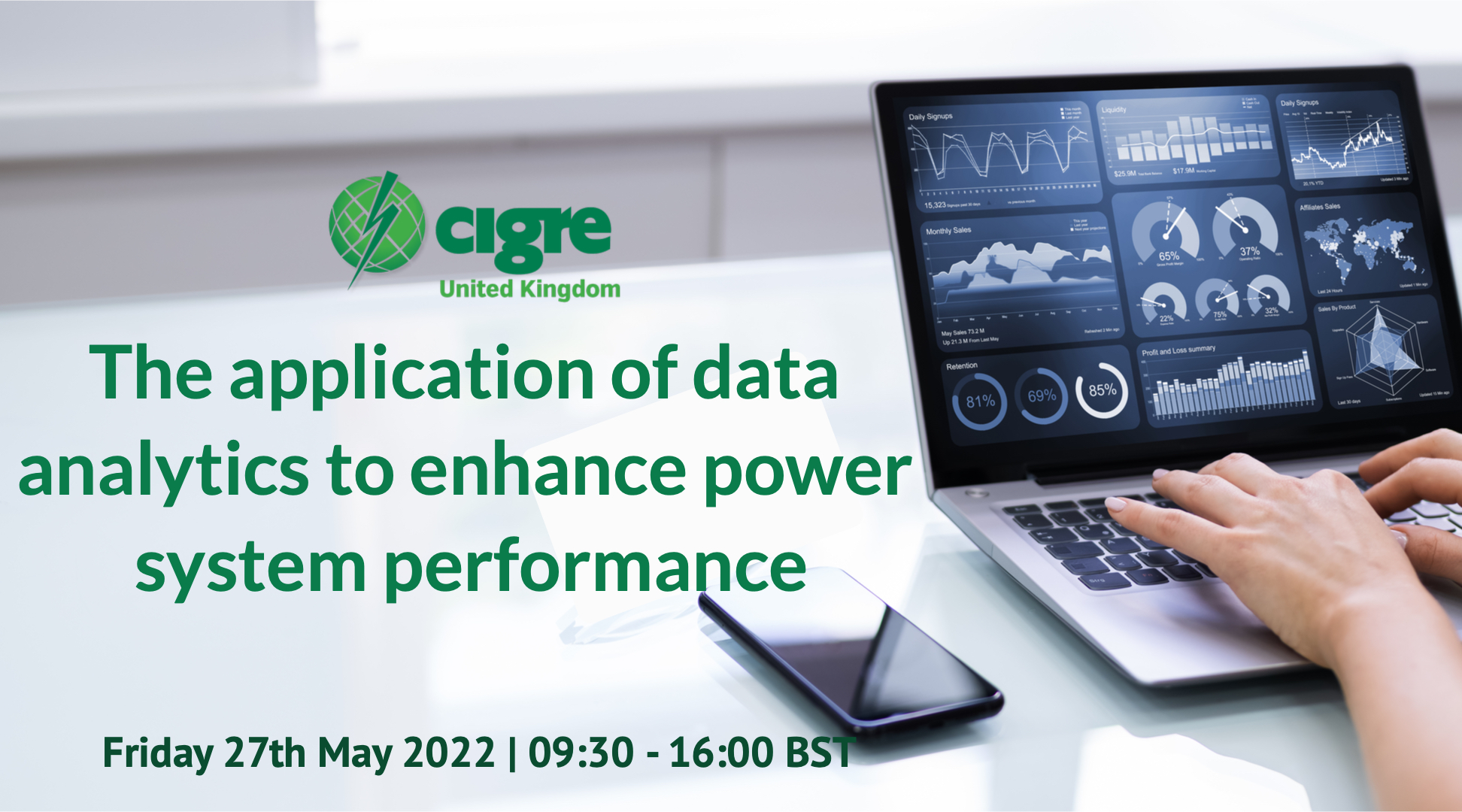
On Friday 27th May, CIGRE UK will be holding a one day conference in London on the subject of ‘The application of data analytics to enhance power system performance’. The event will be Chaired by Prof Gareth Taylor, CIGRE UK (D2) Regular Member and Professor of Power Systems at Brunel University, who will also open the conference. This event is kindly hosted by Arup at its London offices (8, Fitzroy Street, W1T 4BJ) and supported by PSC Consulting/Harmonic Analytics.
–

Agenda
09:30 – 10:00 Arrival/Tea & Coffee
10:00 – 10:10 Welcome & Introduction & Keynote: Gareth Taylor (CIGRE UK Regular Member D2/Brunel)
10:10 – 10:30 Scottish & Southern Energy’s digital strategy – from a business and IT perspective: Steven Gough & Shailesh Kumar (SSE)
10:30 – 10:50 “The role of AI/ML to improve operational response and safety in the distribution and transmission sectors”: Arvin Lim & Michael Kean (PSC Consulting)
10:50 – 11:10 “Virtual Energy Systems – the world’s first whole energy system digital twin”: Andy Kervell, Beatrice Nassi & Jonathan Barcroft (ARUP & NG ESO)
11:10 – 11:30 “Consistency, context and open data – analytics as an enabler”: Gordon Jahn (Open Grid Systems)
11:30 – 12:00 Panel Session (Q&A)/Session Summary
12:00 – 13:00 Buffet Networking Lunch
13:00 – 13:20 “The secure movement of data from edge to core”: Simon Hoy (Vysiion)
13:20 – 13:40 “Using physics-based deep learning for early LV fault location”: David Brain & Hojjat Akhondi-Asl (Fundamentals)
13:40 – 14:00 “Data as an enabler for increased network reliability and low carbon technology integration”: Samuel Jupe (CIGRE UK Regular Member C6/Nortech)
14:00 – 14:20 “Probabilistic stability – An active-learning based approach to support long-term transmission system planning under uncertainty”: Max McFarlane (TNEI)
14:20 – 14:40 Networking Tea/Coffee
14:40 – 15:00 “Into the crystal ball – predicting Low Voltage power network failures before they happen”: Dave A Roberts (EA Technology)
15:00 – 15:20 “Data driven thermal ratings for overhead lines”: Dan Jones (Digital Engineering)
15:20 – 15:50 Panel Session (Q&A)
15:50 – 16:00 Wrap-up
Take this opportunity to learn from and network with industry experts. Places are limited so please book now!
Covid-19 customer safety
The safety of guests attending our events is our top priority. We continue to follow the latest government guidance and we are promoting their Safer Behaviours as part of their ‘Living with COVID-19’ plan.
Presentation synopsis
Arvin Lim & Michael Kean (Power Systems Consultants) “The role of AI/ML to improve operational response and safety in the distribution and transmission sectors”
The increase in telemetry, devices and transition-driven complexity is resulting in escalating volumes of alarms and events across electricity transmission and distribution networks. This situation can increase operator fatigue and the chance of human error, as well as masking the visibility of underlying network health problems. In addition, alarm flooding, which may consist of thousands of notifications per minute, further limits the potential for manual resolution. Machine learning can be used as a means to automate several activities related to the resolution of these alarms, improving operational KPIs and reducing cost. Benefits include; Reduces operator fatigue, minimise human error; Mitigates management overhead from increase in connected IoT devices and points; Reduce reliance on ageing workforce. Applications include; Dashboards & visualisation of alarm performance; Automatic triaging of problem alarms to business owners; Approaches (implemented and proposed) to classify problem alarm classification (Text classification, Alarm/point classification, Association rules, Mutation analysis).
Andy Kernel, Beatrice Nassi & Jonathan Barcroft (ARUP & NG ESO) “Virtual Energy Systems – the world’s first whole energy system digital twin”
The presentation will provide an overview of the recent project phases of the ESO Virtual Energy System (VirtualES) – the world’s first whole energy system digital twin. The VirtualES will be a digital replica of Britain’s entire energy landscape, providing a virtual environment to share data, model and predict scenarios that will support the decarbonisation of the energy industry, while supporting a digital-first and sustainable resilient energy network for the future. The ESO are currently leading the project programme but since the VirtualES will be a collaboration across the whole-system, in partnership with a technical consortium led by Arup, with support from Energy Systems Catapult, and Icebreaker One. The project programme partners bring expertise in digital twins, systems-thinking and energy data. The latest phase of work has also engaged with project partners who bring the perspectives of electricity network asset owners (NGET, SPEN, SSEN Transmission, SSEN Distribution, WPD) and gas network participants (NGGT, NGN).
Gordon Jahn (Open Grid Systems) “Consistency, context and open data – analytics as an enabler”
In this presentation we outline that within the UK various energy service markets (direct contracts, balancing market, PAS services, aggregators…) are enabling investors and innovators to find ways of providing support to the energy market and getting paid for their involvement. This drives further investment, but investors want bang for their buck… so they want to be able to find the best places to site their equipment. The approach taken is to give the market the data and let them figure out the best strategy – but the UK landscape has had various Excel-based ways of utilities giving forward information and how this relates to the network has historically been quite opaque – the regulator has now embraced that strategy that everything should be open unless there’s a reason (e.g., confidentiality) not to. The regulator is pursuing the CIM as a data interchange standard with standard profiles, and whilst we work on this for LTDS, the other things (like network development statement, etc) may well follow so all market participants have consistent data with the network model (or equivalent where data requires it…) for context. we can then explore the NeRDA design, starting as just substations and data, but that we’ve put a CIM model behind it, and have exposed raster images of line routings – this is slowly building out with substations, etc. There are challenges in Open Data – we have data on different provider systems and sitting within OT environments and delivering this in near-Realtime isn’t the easiest, especially with some systems having fixed data formats and non-standard APIs. Cover the project approach, the backend, the data flows, the audit logs, the full APIs exposed and the APIM approach to limiting access using RBAC… highlight that this means the utility starts exposing open data but has more to release as it’s cleared for release and as understanding as to the formats for that data are understood.
Simon Hoy (Visiion) “The secure movement of data from edge to core”
Demand to access data collected at the edge to improve system performance is on the increase, much of this information originating from devices connected to disparate operational technology (OT) networks. The ability to bring this data into the information technology (IT) domain is essential to enabling the smart and sustainable networks of the future. This presentation will set out the challenge, considerations, and approach, to bridging the OT and IT technology gap, ensuring reliable and secure M2M, M2P, and P2P connectivity; Understanding the elements – edge to core, technology, protocols, latency, and bandwidth; Bridging the gap between operational and information technology networks; Cyber security, best practice across IT and OT. The ability to assimilate real time operational data from disparate but connected systems, ensure this can be disseminated to stakeholders at the right time and in context, has the potential to vastly improve the efficiency, performance, and reliability, of the UK power network. This presentation sets out the fundamental building blocks needed to tackle the challenges of IT/OT integration, cyber security, and connectivity, ensuring high value data gets to the right place, and right people, at the appropriate time.
David Brain & Hojjat Akhondi-Asl (Fundamentals) “Using physics-based deep learning for early LV fault location”
LV faults are an ongoing problem for DNOs and make a significant contribution to Customer Minutes lost. There are a number of conventional solutions to this, but all require faults to progress to an advanced stage close to fuse rupture. This means that maintenance procedures must be purely reactive in nature. In this presentation we will describe a new approach which uses deep machine learning applied to feeder waveforms which enables LV faults to be detected, classified and accurately located at a very early stage in their evolution. This opens up new possibilities for proactive maintenance and cable health monitoring.
Samuel Jupe (CIGRE UK Regular Member C6/Nortech) “Data as an enabler for increased network reliability and low carbon technology integration”
soon to be announced
Max McFarlane (TNEI) “Probabilistic stability – An active-learning based approach to support long-term transmission system planning under uncertainty”
Traditionally angular stability has only ever been explored through summer minimum and winter maximum scenarios. More often than not, this is due to the incredible computational burden that’s required with running these dynamic simulations. To address this challenge TNEI and NGESO have used cutting-edge techniques to support long-term planning under uncertainty. This combines traditional power systems stability analysis with statistical and machine learning methods such as efficient sampling methods, network reduction for dynamic equivalents and, active learning. This will allow NGESO to better understand quantify the risk and uncertainty associated with angular stability on the GB electricity system.
Dave A Roberts (EA Technology) “Into the crystal ball – predicting Low Voltage power network failures before they happen”
Power networks, and particularly the last mile, are experiencing dramatic changes as we, the citizens, switch to electrified heat and transport. These vast, and largely aged networks, have operated on a ‘fit-and-forget’ basis since they were installed, with only periodic demand checks at transformer level. But all that is now changing. LV feeder monitoring is becoming more necessary to ensure the grid operates within limits, but what else can this provide…? High fidelity monitoring coupled with analytical techniques / clever algorithms are opening up the grid in ways we could only have dreamt; not just showing how demand changes between days, months, years, but also detecting faults BEFORE THEY HAPPEN. Not just IF they will happen, but specifically WHERE and WHEN. Imagine that: a power system where repairing faults with grumpy businesses and citizens off-supply is a thing relegate to history.
Dan Jones (Digital Engineering) “Data driven thermal ratings for overhead lines”
This presentation will show how weather data and line rating software can be combined to provide enhanced probabilistic ratings for overhead lines.



